1 The Story of SMASHfestUK
Many people, including families living with multiple deprivations, and black, black-heritage, and black mixed-heritage families, are under-served by existing informal science learning (ISL) provisions and under-represented in STEAM study choices and careers [Archer et al., 2013 ; Neelands et al., 2015 ]. SMASHfestUK is a science and arts festival that was established in 2015 specifically to engage underserved and under-represented communities, and its approach to community engagement was a co-design lead iterative prototyping of the festival and the events within it. This approach was developed into a model for inclusive engagement called “SCENE” (STEAM/Community/Entertainment/Narrative/Enquiry). SMASHfestUK was delivered in Deptford, South East London from 2015–2019, but also delivered “pop-up” events in other areas of England and Wales including Colindale, Woolwich, Gloucester, Bradford, and Neath (Figure 1 ).

(a)
|
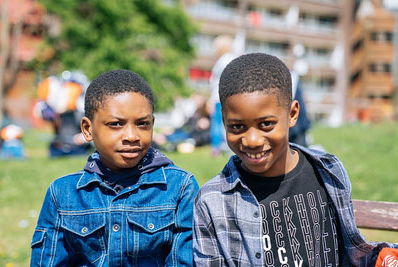
(b)
|
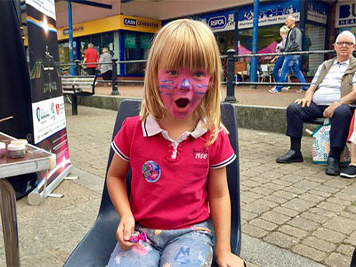
(c)
|
This co-design process involved the active participation of stakeholders, including target communities, collaborating organisations and funding bodies. This determined that each festival would be driven by the story of a fictional natural disaster; a ‘unifying threat to humanity’. The story was adapted for each location so that it became specific and meaningful for each participating community; an approach we describe as ‘hyperlocal’. SMASHfestUK has a focus on the use of ordinary, everyday, accessible locations in town-centres, community halls, libraries and other public spaces; spaces which have a high public footfall and a low barrier to access for marginalised communities. The overarching “disaster narratives” used in the festival create scenarios for performances, demonstrations and interactive experiences that encourage communities to understand the impact and importance of the STEAM that underpins our everyday lives by exploring what would happen if they lost their housing, habitats and infrastructure. It calls on participants to “save the world” or to rebuild civilisation, or even inhabit space. This commentary explores the various manifestations of the approach and principles in differing community settings. These include a local community library and social space (The Deptford Lounge), a community theatre (The Albany, SE8), a central town library (Gloucester), a central public town square (Centenary Square, Bradford), a “Market Square” at the centre of the main town shopping zone (Neath), and in Colindale, open ground at the centre of the Grahame Park Estate, one the U.K.’s largest social housing schemes. All events were well-attended with a good representation from groups normally marginalised by science festivals. This commentary explores the reasons why local communities who are socio-economically disadvantaged can be found in neglected spaces, using the voices of that community to tell their story, and illustrating the power of listening, locality and co-design to empower and engage underserved audiences.
This is the story of SMASHfestUK through the words of the people who co-designed, co-produced it, and shaped it: the participant community [McKenzie, 2015 ; Jarvis, 2016 ; Simons, 2017 ; Simons, 2018 ].
“Nobody ever comes here…”
2 Listening: people, places, insights, stories, a process
Co-design in the context of SMASHfestUK was considered as a form of participatory action research (Figure 2 ), processes that have been found to be effective in the successful creation of effective end “products” or “services” as well as empowering citizens and positively affecting policy [Bardill et al., 2010 ; Sanders and Stappers, 2008 ; Voorberg, Bekkers and Tummers, 2015 ; Conway, Masters and Thorold, 2017 ]. The early co-design process showed a gravitation by young people we worked with towards excitement, adrenaline and adventure. With the process providing prompts, we asked; “What if…?” Answers and ideas flowed freely, “A news reporter tells us…”, “that perhaps there’s a…?” “Disaster!”, “Fire!”, “Earthquake”, “Plague!”, “There was another meteorite!” But where? “In Deptford!” “Our houses and food had been burned.” “Zombies”, “People were turning into zombies…” We could…? “Go on an adventure!”
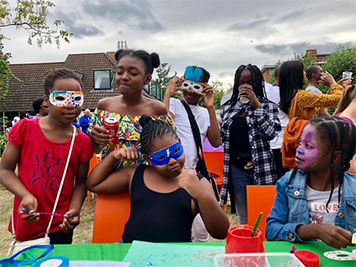
(a)
|
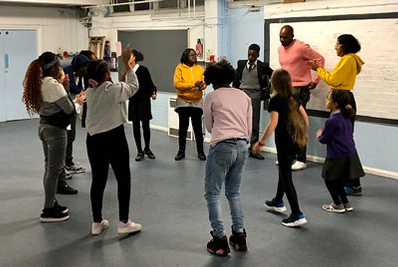
(b)
|
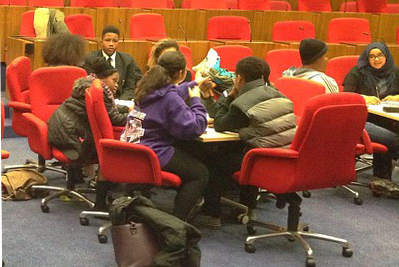
(c)
|
For some co-designers the follow-on effects of these types of comments from young people seemed clear: “I just realised that if we introduce STEM subjects to these children especially the very young ones. We can inspire them to be more interested in them. We can let them know that these subjects shouldn’t be things that we grow up to avoid or develop a fear for.”
And for the designers and artists who would work with the festival the insights were equally important; “Being able to carry out co-design workshops in the primary school we visited as a team of designers it allowed me to understand the thought process of the children as well as how they communicate and interact with each other and the grown-ups around them.”
3 More listening: where? Who?
Various studies from health and public engagement settings have shown that there is “distance from university penalty” for engagement activities and that researchers travelling to community spaces was an effective (if resource-heavy) way to reach people who were historically dubbed “hard to reach” [Bonevski et al., 2014 ; McCracken, 2017 ; Audience Agency, 2018 ]. For this reason it was decided that the festival would create events in the heart of the communities we wanted to reach. When Swansea Science Festival asked us to participate, we asked “which local communities won’t you reach?” “Neath” was the answer and so the festival went to Neath. Neath is among the most disadvantaged areas in Wales. Any activities they said, “that can be taken to the region would have a hugely beneficial impact”. Nevertheless we received warnings from some quarters. “Whatever you do, don’t go to the Grahame Park Estate”, but these warnings were eclipsed by expressions of surprise by visitors at events; “No-one ever comes here…”, “Why are you here?”, “What are you doing here today? No-one ever comes here”.
4 The premise: neglected communities, excluded groups and access to Informal Science Learning
Although it has been reported that the barriers to inclusion are many [Dawson, 2014 ; Dawson, 2019 ; Whitaker, 2016 ; Audience Agency, 2018 ], it was important to hear the voices of our audiences telling us their experiences. Audiences shared the reasons why it was important to reach their communities. “Often people in deprived areas feel that arts and science is not accessible to them”, they stressed that “being free is so important, because people in this area really struggle”. There was an emphasis in comments on cost-based exclusion, “parents from Deptford cannot always afford it [the cost of entry to paid-for activities] — ordinary working mums. They need things that they can do in half term”. There were “not many opportunities in Deptford for kids [that are affordable]”.
Participants also expressed sadness that the lack of activities was linked to, what they perceived as, low community cohesion: “Nothing, like this happens where I live and there is no real sense of community. But it is hard, you know, to engage people from deprived areas”. Others commented “so many parents said that usually there is nothing in Deptford for children”. SMASHfestUK illustrates arguments for the role of “placemaking”. Placemaking uses arts and culture to underpin revitalisation and promote community cohesion, however there are also arguments that placemaking simply underpins neoliberal ideologies and that “placeguarding” through arts activism is a more equitable approach to promoting arts and culture in marginalised communities [Markusen, 2014 ; Thomas, Pate and Ranson, 2015 ; Pritchard, 2018 ]. As such, in Deptford, the thoughts of parents and carers were echoed by younger participants who are aware of the exclusionary and divisive effects of “regeneration” and had linked the presence of arts and culture with that same gentrification:
“It’s important that SMASHfestUK is in Deptford because there’s a lot of gentrification and new development. What was a ‘bad’ area is being sorted out and it’s great that there are events like this that bring a chance to people who wouldn’t usually engage.”
One particular demographic group marginalised by many forms of ISL are Black, Black heritage and Black mixed-heritage communities [Archer et al., 2013 ; Dawson, 2018 ]. A young adult contributor to the festival noted the importance of the event to his community personally; “to get STEM to underprivileged and low-income areas and families is something that is absolutely needed. As someone from a BAME background myself, I see the importance of making STEM exciting and creative as well as informative as I was often put off and not interested by STEM as a child”.
5 Equity, representation and inclusion
Recurring themes described neighbourhoods in which communities who felt excluded from cultural institutions or higher educational establishments. These communities were empowered by the presence of people representing these organisations in their own space (Figure 3 ): “…it [SMASHfestUK] gets people excited. It is a gateway to a sense of something different that opens up ideas beyond the everyday. Bringing experts in from universities as well as creative arts people is an inspiring and imaginative approach to engaging people in science and empowering them to think more about their world”.
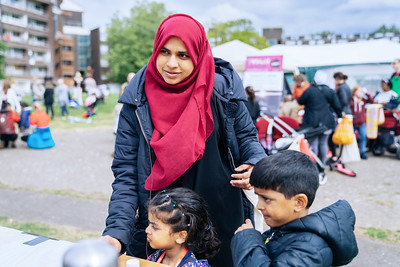
(a)
|
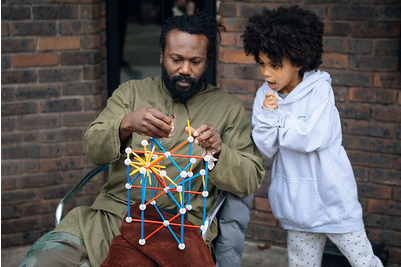
(b)
|
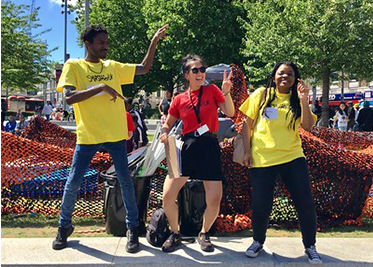
(c)
|
There is evidence regarding the importance of role models in STEM engagement [Herrmann et al., 2016 ; Shin, Levy and London, 2016 ], so ensuring diversity in staffing of the festival was important and this was noted by audiences. “Seeing different people from different backgrounds coming together for one cause was quite beautiful”. Audiences brought absolute clarity to the necessity of this approach:
“For people of colour, the yardstick [for science and engineering] is very much white males — so to see women and women of colour in leadership and in engineering roles here — they are being influenced by that and it is a big confidence boost. In the U.K. we are always seen as the minority — ‘other than’ — and I don’t want my children to feel this… I know how much representation matters in making choices and seeing yourself in a role.”
Equitable representation of ethnicity was extremely important, but it was also important for the building of strong science identities in girls [Steinke, 2017 ], that we had broadly equal representation of women scientists:
“Lots of adults and young people coming together to have fun and learn. And it’s free! Affordable activities that have thrilled my daughter throughout her holiday. A local event for friends and family. Inspiring my daughter that science is fun, is artistic and is for girls.”
Other visitors reported on the importance of the festival in encouraging intergenerational learning and rekindling a love of science in adult visitors, who were mostly parents or carers:
“I actually like doing these activities myself, I used to know how to do this — but I forgot — so it is good to learn these skills again. I do actually work with children.”
Intergenerational learning (Figure 4 ), leading to discussions with family members is known to be another effective way of embedding science in families, and also sustains progression in learning [Dou et al., 2019 ], and so where possible this was fostered and seemed to have a positive effect with visitors. They described, “we talked about it [the festival] quite a bit and remembered what we had done and which our favourite bits were” and how “[SMASHfestUK] sparked many conversations amongst us… as well as looking into qualifications and career routes”.
“My son wrote about it in his journal and we bring up things we heard and learned on the day in daily activities. We will refer back to Smashfest events in future activities. He continues to show others his science experiment papers so is learning by retelling it each time.”
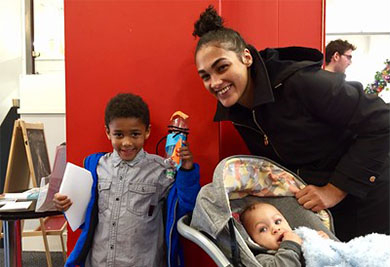
(a)
|
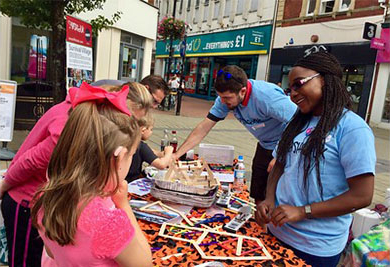
(b)
|

(c)
|
6 Personal, community and collaborative futures
For some young adults, the experience of SMASHfestUK crystallised their intentions to follow a STEM career: “I met science experts — seeing what other people do was mind-blowing as I’d never actually met people who work in such scientific fields or pursue academic careers… if they can do it — why can’t I do it too?”. The experiences also highlighted to young adults the possible opportunities for younger participants, including siblings:
“They don’t see these sorts of things in the rigid environment of school and they can’t explore these sorts of ideas for free which is important in an area with a lot of poverty and where kids get limited exposure to opportunities. This has a knock-on effect because it means as kids progress they can’t recognise opportunities or have the skills to know what to do even when opportunity is facing them — and they are unsure how to engage.”
The collaboration-based approach to the festival also provided the beginnings of a community of practice amongst researchers and practitioners engaging with the co-design and inclusion principles. One said: “I feel SMASHfestUK has had a direct benefit on me as a local resident as well as a practitioner. It’s enormously important that all communities have a place to congregate and moments in the year which lift us out of the ordinary and give us cause to think about who we are as people and as a society”. Another reflected upon the effect of SMASHfestUK’s approach on their personal practice saying; “Collaborations are useful for creativity as you see other people’s interpretations and views, so can learn a lot and can develop something even better”. In some cases the effect of participation was to change pedagogical practice, with a Senior Lecturer noting: “These events have really underpinned for me the importance of tangible, easily explored examples to motivate and understand engineering problems. Physical manipulation of a problem is a really powerful way of fostering engagement, and I’m looking now to apply this principle to the purer ends of the mathematics I teach”. But, the importance of the co-design process also conferred a sense of ownership to visitors: “Because they are making or doing things themselves the children have a personal investment with the arts and science because it is tangible — they can take it home”.
Using stories and immersion (Figure 5 ) encouraged visitors to create personal narratives, and in doing so, through the process of narrative transportation, they built a positive and sustainable science identity [Green and Brock, 2000 ; Gallagher, 2011 ; Keith and Griffiths, 2020 ] and their responses in evaluation suggest this may be effective. Asked what they had learnt as a result of the experience, our young audiences responded, positively: “I AM a scientist!” and “I saved the world!”, “Science is Awesome!”, and “I am a HERO!”, whilst, adult visitors were more contemplative; “I did the immersive Montserrat volcano experience — listening to the kids reveal their volcano stories made me ponder and imagine that I was there”. Some ascribed the learning to the story and immersion directly; “I think the immersive aspect was the most important. The kids were constantly engaged and it helped get the message across”. At an event in February 2020, which told the story of a novel disease causing a pandemic, one adult said “…almost as weird as real life!” and again, made a link to the the future of the audience members: “I truly believe that the work SMASHfestUK do… allows children to understand concepts in an engaging manner. It is the work of organisations such as this that will see young children want to go into a STEM career whilst still being creative and considerate”. And even those who did not enjoy it themselves, saw some benefits; “I’m not a fan of ‘immersive’ events — I find it claustrophobic. But I think my children enjoyed it!”
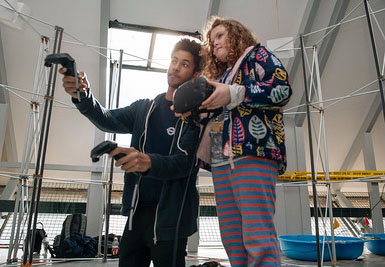
(a)
|

(b)
|
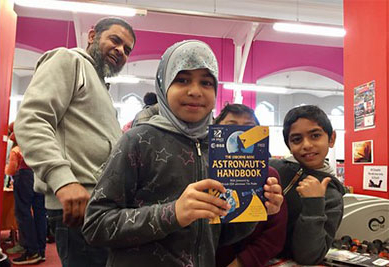
(c)
|
The specificity of being immersed in local stories, that felt personal and bespoke, was recognised:
“The activities give them an insight into how they would cope if there was a flood and what could be done… The issue of growing things after a flood, we had a discussion about back at the kid’s club, because all of the soil would be flooded — so you could grow some plants just in water — the children were really interested in that and it started a really interesting conversation with them.”
7 Concluding for the next cycle
The SMASHfestUK approach is to consider each event an iterative prototype; always changing, always improving and always requesting feedback. Future suggestions include “more themes”, “even more storytelling”, “extra activities”, “more for under 6’s”, and “crib sheets… to take away” and to “be [available] at home”.
Having explored the advantages of the SCENE model for engagement through live events and festivals, our next iteration of the model will be engaging through digital means. The development of SCENE (STEAM/Community/Entertainment/Narrative/Enquiry) has interwoven with, and driven, the festival and co-design programme cycle. The headline SCENE components — interdisciplinary/cross-sectoral, “in the community, with the community”, lead on entertainment, the narrative drives all levels of the experience, and the engagement is active and enquiry-based — are illuminated through the reflections of the participants in this commentary. The next, digital, iteration will be within a videogame, exploring how these SCENE model components and the effect of building positive science identities through narrative transportation might be replicated online and at home. This intends to deepen the relationship with ‘narrative transportation’, but critically, will continue to embed each player’s experience locatively in their own community. Personalised, localised digital engagement offers the potential to reach more communities, for longer, more repeatedly, providing more content, and more experiences than the resource-heavy live experience model, however, issues surrounding digital exclusion bring their own addition challenges and these will have to be addressed.
In summing up, we point to a critical study of exclusion in science engagement which ended with a call to arms: “We could commit ourselves to a total radical alternative to the types of everyday science learning that currently exist. It may be hard to imagine what this could look like… but together we can envision and manifest this alternative” [Dawson, 2019 ]. We have co-designed with our collaborating communities for six years resulting in a set of principles underpinning a new model for inclusive engagement, “SCENE” and exploring how we might make SCENE work in the digital space is our next step in trying to understand this challenge.
References
-
Archer, L., DeWitt, J., Osborne, J. F., Dillon, J. S., Wong, B. and Willis, B. (2013). ASPIRES Report: Young people’s science and career aspirations, age 10–14. London, U.K.: King’s College London. Department of Education & Professional Studies. URL: https://www.kcl.ac.uk/ecs/research/aspires/aspires-final-report-december-2013.pdf .
-
Audience Agency (2018). Museums Audience Report . URL: https://www.theaudienceagency.org/asset/1995 .
-
Bardill, A., Griffiths, W., Fields, B. and Jones, S. (2010). ‘Design Tribes and information space for creative conversations’. In: DS 62: Proceedings of E&PDE 2010, the 12th International Conference on Engineering and Product Design Education — When Design Education and Design Research meet… (Trondheim, Norway, 2nd–3rd September 2010). Ed. by W. Boks, W. Ion, C. McMahon and B. Parkinson, pp. 556–561.
-
Bonevski, B., Randell, M., Paul, C., Chapman, K., Twyman, L., Bryant, J., Brozek, I. and Hughes, C. (2014). ‘Reaching the hard-to-reach: a systematic review of strategies for improving health and medical research with socially disadvantaged groups’. BMC Medical Research Methodology 14, 42. https://doi.org/10.1186/1471-2288-14-42 .
-
Conway, R., Masters, J. and Thorold, J. (2017). From design thinking to systems change: how to invest in innovation for social impact. London, U.K.: RSA Action and Research Centre. URL: https://www.thersa.org/globalassets/pdfs/reports/rsa_from-design-thinking-to-system-change-report.pdf .
-
Dawson, E. (2014). ‘“Not designed for us”: how science museums and science centers socially exclude low-income, minority ethnic groups’. Science Education 98 (6), pp. 981–1008. https://doi.org/10.1002/sce.21133 .
-
— (2018). ‘Reimagining publics and (non) participation: exploring exclusion from science communication through the experiences of low-income, minority ethnic groups’. Public Understanding of Science 27 (7), pp. 772–786. https://doi.org/10.1177/0963662517750072 .
-
— (2019). Equity, exclusion and everyday science learning: the experiences of minoritised groups. 1st ed. London, U.K.: Routledge. https://doi.org/10.4324/9781315266763 .
-
Dou, R., Hazari, Z., Dabney, K., Sonnert, G. and Sadler, P. (2019). ‘Early informal STEM experiences and STEM identity: the importance of talking science’. Science Education 103 (3), pp. 623–637. https://doi.org/10.1002/sce.21499 .
-
Gallagher, K. M. (2011). ‘In search of a theoretical basis for storytelling in education research: story as method’. International Journal of Research and Method in Education 34 (1), pp. 49–61. https://doi.org/10.1080/1743727X.2011.552308 .
-
Green, M. C. and Brock, T. C. (2000). ‘The role of transportation in the persuasiveness of public narratives’. Journal of Personality and Social Psychology 79 (5), pp. 701–721. https://doi.org/10.1037/0022-3514.79.5.701 .
-
Herrmann, S. D., Adelman, R. M., Bodford, J. E., Graudejus, O., Okun, M. A. and Kwan, V. S. Y. (2016). ‘The effects of a female role model on academic performance and persistence of women in STEM courses’. Basic and Applied Social Psychology 38 (5), pp. 258–268. https://doi.org/10.1080/01973533.2016.1209757 .
-
Jarvis, P. S. C. (2016). SMASHfestUK 2016 — Solar Storm! Evaluation . URL: https://gala.gre.ac.uk/id/eprint/19844/ .
-
Keith, L. and Griffiths, W. (2020). ‘“Space Plague”: an investigation into immersive theatre and narrative transportation effects in informal pandemic science education’. JCOM 19 (07), N01. https://doi.org/10.22323/2.19070801 .
-
Markusen, A. (2014). ‘Creative cities: a 10-year research agenda’. Journal of Urban Affairs 36 (sup2), pp. 567–589. https://doi.org/10.1111/juaf.12146 .
-
McCracken, S. (2017). ‘School engagement in STEM enrichment: effect of school location’. I’m a Scientist . URL: https://about.imascientist.org.uk/2017/school-engagement-in-stem-enrichment-effect-of-school-location/ (visited on 21st September 2020).
-
McKenzie, B. (2015). SMASHfestUK 2015 — Asteroid! Evaluation report . URL: https://gala.gre.ac.uk/id/eprint/19848/ .
-
Neelands, J., Belfiore, E., Firth, C., Hart, N., Perrin, L., Brock, S., Holdaway, D. and Woddis, J. (2015). Enriching Britain: culture, creativity and growth. The 2015 report by the Warwick Commission on the future of cultural value. Coventry, U.K.: The University of Warwick. URL: https://warwick.ac.uk/research/warwickcommission/futureculture/finalreport/warwick_commission_final_report.pdf .
-
Pritchard, S. (2018). ‘Place guarding: activist art against gentrification’. In: Creative placemaking: research, theory and practice. Ed. by C. Courage and A. McKeown. London, U.K.: Routledge.
-
Sanders, E. B.-N. and Stappers, P. J. (2008). ‘Co-creation and the new landscapes of design’. CoDesign 4 (1), pp. 5–18. https://doi.org/10.1080/15710880701875068 .
-
Shin, J. E. L., Levy, S. R. and London, B. (2016). ‘Effects of role model exposure on STEM and non-STEM student engagement’. Journal of Applied Social Psychology 46 (7), pp. 410–427. https://doi.org/10.1111/jasp.12371 .
-
Simons, N. (2017). SMASHFestUK 2017 evaluation report . URL: http://sciencefestivals.uk/wp-content/uploads/2016/02/SMASHfestUK-2017-evaluation-report.pdf .
-
— (2018). SMASHfestUK evaluation 2018: “Flood!” URL: https://gala.gre.ac.uk/id/eprint/28766/ .
-
Steinke, J. (2017). ‘Adolescent girls’ STEM identity formation and media images of STEM professionals: considering the influence of contextual cues’. Frontiers in Psychology 8, 716. https://doi.org/10.3389/fpsyg.2017.00716 .
-
Thomas, E., Pate, S. and Ranson, A. (2015). ‘The Crosstown initiative: art, community, and placemaking in Memphis’. American Journal of Community Psychology 55 (1–2), pp. 74–88. https://doi.org/10.1007/s10464-014-9691-x .
-
Voorberg, W. H., Bekkers, V. J. J. M. and Tummers, L. G. (2015). ‘A systematic review of co-creation and co-production: embarking on the social innovation journey’. Public Management Review 17 (9), pp. 1333–1357. https://doi.org/10.1080/14719037.2014.930505 .
-
Whitaker, S. (2016). Hurdles to the participation of children, families and young people in museums: a literature review. URL: https://docs.google.com/viewer?url=https%3A%2F%2Fkidsinmuseums.org.uk%2Fwp-content%2Fuploads%2F2018%2F12%2FHurdles-to-Participation.pdf .
Authors
Mr. Wyn Griffiths BA, MSc, FRSA, Senior Lecturer, Middlesex University, Department of Design Engineering and Mathematics, School of Science and Technology. Wyn is Principal Investigator for the STFC Nucleus Award funded ‘Space Plague’ project, researching immersive theatre and narrative transportation effects in informal STEM education, and teaches in Product Design and Product Design Engineering. His work spans many sectors and a disparate range of public engagement arenas, including event, installation, experience and exhibition design, build and management. His recent work includes conceiving, founding and running SMASHfestUK, with The Refinery; creating large scale mechanical installations such as the Globe of Dislocation, exhibited in the Royal Observatory Courtyard in 2014/15 as part of their Longitude Punk’d Exhibition and the Stained Glass “Car of the Future” — a physical thought experiment with designer Dominic Wilcox for BMW, Mini and Dezeen, and designing and running ‘Robot Overlords’, an immersive robotics experience, exploring the perception and reality of robotics technology and social penetration for London Design Festival 2015. E-mail: w.griffiths@mdx.ac.uk .
Dr. Lindsay Keith BSc PhD, PGCertHE Lindsay is a multi BAFTA nominated film-maker, festival producer, writer and creative research fellow at the University of Greenwich. After completing her PhD in Infectious Disease at Imperial College London, she worked in broadcast TV, producing and directing specialist factual and observational documentaries, and mainstream factual-entertainment programmes for BBC1&2, Ch4, five, Sky, Discovery, and History channels. In 2011 she founded creative production company, The Refinery and in 2014 co-founded SMASHfestUK, an award-winning immersive science and arts festival for marginalized young people and families. Since 2015 she has also worked as a research fellow at the University of Greenwich where her research specialism is embodiment and behavior change through immersive narratives. In 2019 and 2020 she co-created, scripted and produced a mixed-media fully immersive work “Space Plague” exploring embodiment and presence in immersive theatre and the role of narrative transportation in changing real-life attitudes. E-mail: l.keith@gre.ac.uk .